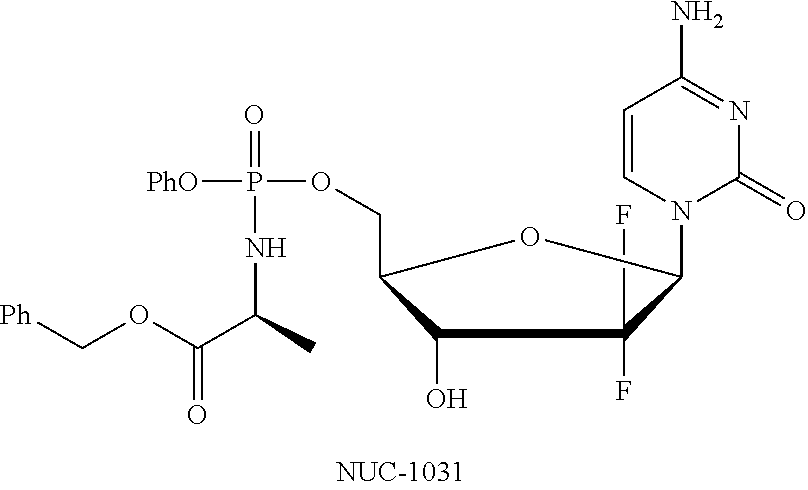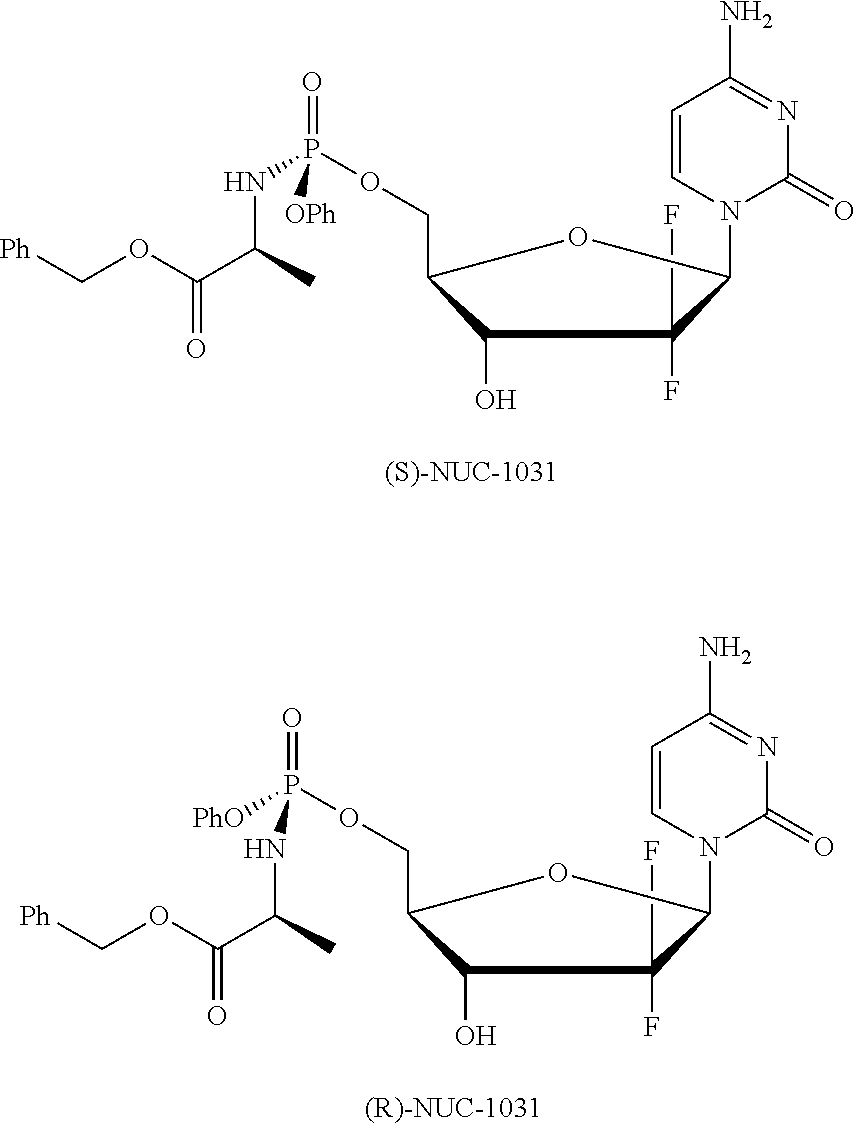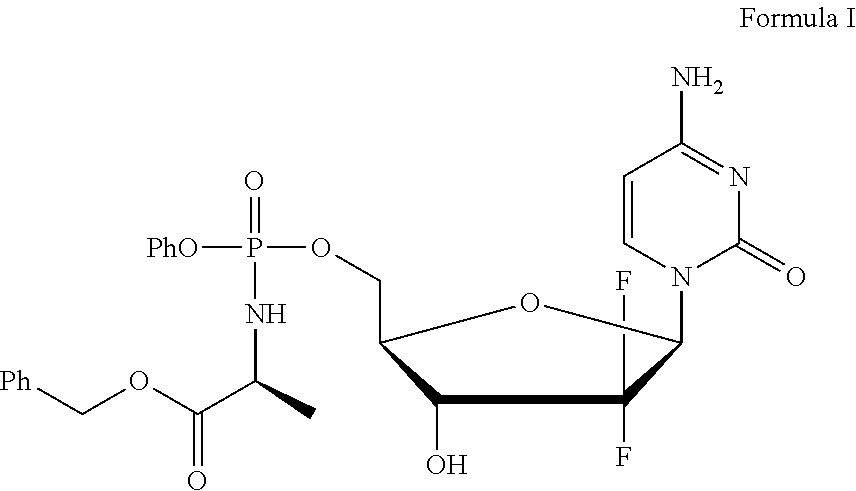Diastereoselective synthesis of phosphate derivatives
a phosphate derivative and selective synthesis technology, applied in the direction of group 5/15 element organic compounds, drug compositions, chemical production, etc., can solve the problems of high cost of hplc-based industrial scale separation process, inhibition of dna synthesis, and blockage of cell division cycle completion
- Summary
- Abstract
- Description
- Claims
- Application Information
AI Technical Summary
Benefits of technology
Problems solved by technology
Method used
Image
Examples
example 1
Preparation of Diastereoisomeric Mixture of 2-[(2,3,4,5,6-pentafluorophenoxy)-phenoxy-phosphoryl amino] propionic acid benzyl ester (Formula IIa)
[0110]
[0111]To a stirred mixture of L-alanine benzyl ester hydrochloride (100 gms) in methylene chloride (1 lit) was added phenyl dichlorophosphate (77 ml) at 25-35° C. and the resulting mixture was cooled to −70° C. to −78° C., added triethyl amine (130.5 ml) and stirred for 1 hrs at same temperature. Reaction mass temperature was raised to 25-35° C. and allowed to stir for 2 hrs. After reaction completion, concentrated the reaction mass under vacuum at below 35° C. to obtain residue. To the obtained residue was added diisopropyl ether (2 lit) at 25-35° C. and stirred for 30 min at same temperature. Filtered the reaction mass and washed with diisopropyl ether (500 ml) followed by concentrating the filtrate under vacuum at below 35° C. to obtain phenyl-(benzoxy-L-alaninyl)-phosphorochloridate. The obtained compound was dissolved in methylen...
example 2
Separation of Sp-diastereoisomer of 2-[(2,3,4,5,6-pentafluorophenoxy)-phenoxy-phosphoryl amino] propionic acid benzyl ester (Formula IIa)
[0114]
[0115]To the above obtained diastereoisomeric mixture of Formula IIa (RP: SP−33.74:66.26%) was charged 20% ethyl acetate in hexane (1.2 lit) at 25-35° C. and stirred for 1 hrs. Filtered the solids and washed with 20% ethyl acetate in hexane (300 ml) to obtain a mixture of compound of Formula IIa.
[0116]Yield: 112 gms
[0117]Chiral Purity by HPLC (% area): 22.13:77.87% (RP: SP)
[0118]Filtrate was concentrated under vacuum to obtain a diastereoisomeric mixture of Formula IIa (75 gm; RP: SP−65.43:34.57%).
[0119]To the above obtained diastereoisomeric mixture of Formula IIa (RP: SP−22.13:77.87%) was charged 20% ethyl acetate in hexane (1.2 lit) at 25-35° C. and stirred for 1 hrs. Filtered the solids and washed with 20% ethyl acetate in hexane (300 ml) to obtain a pure Sp-diastereoisomer of compound of Formula IIa.
[0120]Yield: 80 gms
[0121]Chiral Purity...
example 3
Isomerization of 2-[(2,3,4,5,6-pentafluorophenoxy)-phenoxy-phosphoryl amino] propionic acid benzyl ester (Formula IIa)
[0125]To a stirred solution of above obtained 2-[(2,3,4,5,6-pentafluorophenoxy)-phenoxy-phosphoryl amino] propionic acid benzyl ester of Formula IIa (75 gms; RP: SP−65.43:34.57%) in 20% ethyl acetate in hexane (1.1 lit), triethyl amine (7.5 ml) was added at 25-35° C. and stirred for 6 hrs at same temperature. After reaction completion, reaction mass was quenched in to a water (750 ml) and extracted with ethyl acetate (750 ml). Organic layer was dried with anhydrous sodium sulphate and concentrated under vacuum to afford title compound as a solid.
[0126]Yield: 45 gms
[0127]Chiral Purity by HPLC (% area): 91.29: 8.71% (SP: RP)
[0128]To the above obtained Rp and Sp-diastereoisomeric mixture of 2-[(2,3,4,5,6-pentafluorophenoxy)-phenoxy-phosphoryl amino] propionic acid benzyl ester of Formula IIa (45 gms; RP: SP−8.71:91.29%) was slurred in 20% ethyl acetate in hexane (1.1 li...
PUM
| Property | Measurement | Unit |
|---|---|---|
| temperature | aaaaa | aaaaa |
| temperature | aaaaa | aaaaa |
| temperature | aaaaa | aaaaa |
Abstract
Description
Claims
Application Information
 Login to View More
Login to View More - R&D
- Intellectual Property
- Life Sciences
- Materials
- Tech Scout
- Unparalleled Data Quality
- Higher Quality Content
- 60% Fewer Hallucinations
Browse by: Latest US Patents, China's latest patents, Technical Efficacy Thesaurus, Application Domain, Technology Topic, Popular Technical Reports.
© 2025 PatSnap. All rights reserved.Legal|Privacy policy|Modern Slavery Act Transparency Statement|Sitemap|About US| Contact US: help@patsnap.com



